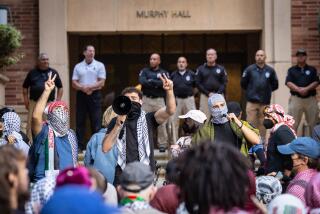Shooting Shatters Sense of Isolation on Campus of USC : Crime: Students from quieter cities and towns are more rattled by the breach of security than are those who grew up in L.A.
The traditional brick buildings and neat green lawns at USC stand in stark contrast to the surrounding areaâs ongoing violence. But on Tuesday, the campus no longer seemed quite so isolated from the outside world.
Everyone, from students to professors, seemed to be talking about Mondayâs shooting that wounded a freshman football player at team practice.
Jon McGee was hit in the arm when a stray bullet from a nearby gang shooting entered Howard Jones Field, police said. McGee said he heard six or seven gunshots, felt something graze his arm and felt his arm go numb. He was taken to California Medical Center where he underwent testing Tuesday.
Police said the bullet came from a gang shootout at Jefferson Boulevard and Vermont Avenue, which is adjacent to the field where the football team usually practices at 3:30 p.m.
Students were surprised that violence strayed into the university grounds, but seemed to be taking it in stride.
âI hear the popping from gunfire--rat-a-tat--every night,â one student told a classmate, as he unlocked his bicycle.
âWell, just donât stand by the window,â she said, laughing. He responded with a shrug.
âIâm from South-Central, so itâs nothing to me,â said Brandon Martin, a freshman who was playing basketball across the street from Jones Field. âI grew up around this.â
âItâs just L.A.,â said senior Ashley Burns. âYou canât just pick up the university and move it to another neighborhood.â
Others from quieter cities and towns reacted differently.
âThere are a lot of people in dorms that are freaking out,â said Heather Burns, a freshman from Glastonbury, Conn., and Ashley Burnâs sister. âThe first thing they did when they found out about the shooting was call their parents and tell them they werenât involved.â
Several students recalled that finals had been canceled or postponed last spring because of the rioting. At that time, the university itself escaped riot damage, but around its perimeter stores were looted and burned. Mondayâs shooting seemed mild to those students, almost acceptable, in comparison to the riots.
âYouâd think that after the riots something wouldâve been done around here,â said Jeff McCollum, a junior. âBut the next thing you know, someoneâs going to get gunned down in front of Tommy Trojan.â
A number of students praised the universityâs security, but said they often felt afraid to go anywhere after dark.
âI almost got shot not too far from here one night,â McCollum said. When he and a friend drove to a liquor store on Vermont Avenue after midnight, he recalled, two men pulled up in front of them, fired two shots over their heads, and drove off.
âAnd you hear things like that all the time,â he said. âAll the girls put cellular phones in their cars because theyâre afraid to get stuck somewhere when itâs dark.â
Despite the violence, university enrollment has remained steady at about 27,500 in recent years, USC officials said. Freshman enrollment actually rose from 2,365 in the fall of 1990, to 2,438 this fall.
âWe encourage our people not to be hardened but attentive, not naive but skillfulâ in avoiding crime, said Robert Biller, vice president of undergraduate affairs. âWeâre all saddened (by the shooting), but we see it as a freak occurrence.â
After the riots, USC President Steven Sample sent a letter to incoming freshmen promising them a secure campus, Heather Burns said, and the letter reassured her that she would be safe.
Most freshmen had already committed to attending USC by the date of the riots. Some students said, however, that they knew of teen-agers from their hometowns who decided not to attend the school because of the violence.
A few faculty members, when asked about safety, just rolled their eyes.
âI like teaching here,â one engineering professor said. âBut Iâm glad Iâm not a student here.â
Although students complained about the randomness of the shooting and the dangers of the surrounding neighborhoods, none blamed the university.
âItâs the city that needs to take care of the problems (in the neighborhood),â Ashley Burns said. âWe saw that in the riots.â
More to Read
Go beyond the scoreboard
Get the latest on L.A.'s teams in the daily Sports Report newsletter.
You may occasionally receive promotional content from the Los Angeles Times.





